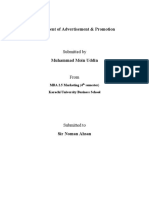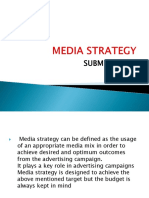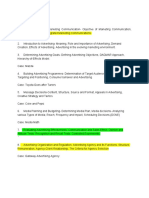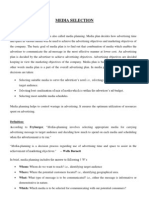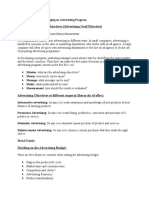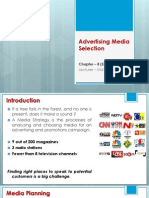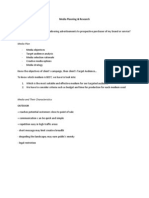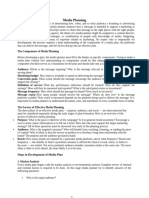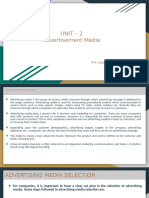Advertising and Direct Marketing
Advertising and Direct Marketing
Uploaded by
Rohit KarakCopyright:
Available Formats
Advertising and Direct Marketing
Advertising and Direct Marketing
Uploaded by
Rohit KarakOriginal Title
Copyright
Available Formats
Share this document
Did you find this document useful?
Is this content inappropriate?
Copyright:
Available Formats
Advertising and Direct Marketing
Advertising and Direct Marketing
Uploaded by
Rohit KarakCopyright:
Available Formats
Advertising and Direct Marketing Topic 8BMedia Buying and Planning Marketers are seeking measurable results for
every marketing communication dollar they spend. Through the use of marketing research organizations, marketers have access to detailed information on the media habits and purchase behaviors of target audiences. Organizations such as Media Research (MRI) and Simmons Market Research Bureau (SMRB) correlate product usage data with the media habits of target audiences (i.e., indexes indicating the particular segments of a population that are heavy users of a particular brand expressed as a share of volume.) Sophisticated data is available through services such as Nielsens Home Scan and Information Resources BehaviorScan, offer information not only on demographics, but on brands, purchase size, purchase frequency, prices paid and media exposure. Media planners identify media that cover the same geographic area as the advertisers distribution system. Geo-targeting is the placement of ads in geographic regions where higher purchase tendencies for a brand are evident (this reinforces high-volume users). A Brand Development Index (BDI) is a method of allocating advertising budgets to those geographic areas that have the greatest sales potential. Message weight is the gross number of advertising messages delivered by a vehicle in a schedule. The measurement includes duplication of exposure. The message weight indicates the size of the advertising effort being placed against a specific market. Gross impressions represent the sum of exposures to all media placement in a media plan. Some are duplicated (the same person had several exposures perhaps through different media ) referred to as between-vehicle duplication as well as within-vehicle duplication (exposed to same ad in same medium on different days.) Media objectives provide the foundation for media selection. The true power of a plan is within the media selection the decisions made with respect to a media vehicles reach and frequency, the continuity of a media placement, audience duplication, length and size of advertisements. Media strategy decisions help ensure that messages placed in the chosen media have as much impact as possible. Reach refers to the number of people in a target audience that will be exposed to a media vehicle or schedule at least one time during a given period of time and is often expressed as a percentage. Media vehicles with broad reach are ideal for consumer convenience
goods like toothpaste with simple features and that are frequently purchased by a broad cross section of the market. Effective reach is the number or percentage of consumers in the target audience that are exposed to an ad a minimum number of times (the minimum number estimate for effective reach is based on a determination of effective frequency. In other words, if effective reach is set for 4 exposures, then a media schedule must achieve this. Frequency is the average number of times an individual within a target audience is exposed to a media vehicle in a given period of time (typically a week or a month). Effective frequency is the number of times a target audience needs to be exposed to a message before the objectives of the advertisers are met (either communication objectives or sales impact.) New brands or brands with features that demand high frequency for consumers awareness whereas a simple message for a well known product requires less frequency. The old rule of thumb was 3 exposures was best, but as few as 2 or as many as 9 may be needed to achieve effective frequency. Continuity is the pattern of placement of ads in a media schedule. Three strategic scheduling alternatives are continuous, flighting and pulsing. Continuous scheduling is a pattern of placing ads at a steady rate over a period of time. Flighting is achieved by scheduling heavy advertising for a period of time, usually 2 weeks, and then stopping advertising altogether for a period to return with another heavy schedule. (A flight is the length of time a broadcasters campaign runs.) This pattern supports special seasonal merchandising efforts or new product introductions or as a response to competitors activities. The advantage of this pattern is that discounts may be gained by concentrating media buys in large blocks. The communication effectiveness is enhanced because a heavy schedule achieves repeat exposures that are necessary to achieve consumer awareness. Pulsing combines continuous and flighting patterns. Advertising is scheduled continuously in media over time periods of heavier scheduling. This pattern is most appropriate for products sold regularly all year long but have, like clothing, certain seasonal requirements. Media planners also make decisions regarding the length or size of an ad. Most television ads are :30, though they can range from :10 to :60 and occasionally 1:20. The length depends on creative requirements, media budgets and the competitive
environment. Advertising attempting to develop an image may need to be longer or larger. A simple message announcing a sale can be short or small but may need heavy repetition. Media Choices: The advertiser and the agency determine which media class is appropriate for the current effort and consider 3 issues: media mix, media efficiency and competitive media activity. The media mix is the blend of different media used to reach the target audience. There are two options: a. concentrated mix and b. assorted mix. A concentrated mix focuses all media placement dollars in one medium. The rationale here is that this approach allows an advertiser to have a great impact on a specific audience segment and gives the brand an aura or mass acceptance especially within an audience with restricted media exposure. Being dominant in one medium heightens brand familiarity particularly in a high visibility medium like television. This also creates enthusiasm and loyalty in the trade channel and thus may impact treatment in inventory or shelf displays. Also, concentrating media dollars in one medium may result in volume discounts from media organizations. An assorted mix employs media alternatives and can be advantageous because it facilitates communication with multiple market segments and an advertiser can place different messages for different target audiences in different media. In this way the message can be tailored to the targets unique interests. Moreover different messages may enhance the learning effect as well as increasing the reach. Media efficiency incorporates the use of various mathematical formulas such as cost per thousand (CPM) and cost per rating point (CPRM). The CPM is the dollar cost calculated for reaching 1,000 members of the audience using a particular medium. CPMs are the standard measure of media efficiency. CPM calculations can be used to compare the efficiency of two media choices within a media class or between media classes. (CPM=cost of media buy as a numerator over the total audience x 1,000 as the denominator). Cost per rating point is the calculation used for television where the cost of a spot on TV is divided by the programs rating (a rating point is equivalent to 1 percent of the television households in the designated rating area tuned to a specific program. The CPRM gives a dollar figure: CPRM = dollar cost of ad placement with a particular program/schedule.
These efficiency assessments are based on cost and coverage and do not consider the quality of the advertising and therefore can not be considered as indicators of advertising effectiveness. Competitive media activity or assessment provides a perspective for the brand. This is important for product categories in which the competitors are focused on a narrowly defined target audience (snack foods, soft drinks, beer, chewing gum). When the target audience is narrow and attracts the attention of several competitors, an advertiser must assess the competitors spending and their share of the voice. The share of the voice is a calculation of any one advertisers brand expenditures relative to the overall spending in a category: share of voice = one brands advertising expenditures in a medium as a numerator over the total product category advertising expenditures in a medium as the denominator. Research provides an assessment of the share of the voice so that advertisers can know what their competitors are spending.
You might also like
- The Sum of The Reach Number of Specific Media Vehicles in A Given Media Plan Gives The Message Weight Is Expressed in Terms of Gross Impressions or Gross Rating Points (GRP)Document10 pagesThe Sum of The Reach Number of Specific Media Vehicles in A Given Media Plan Gives The Message Weight Is Expressed in Terms of Gross Impressions or Gross Rating Points (GRP)keen writerNo ratings yet
- Assignment of Advertisement and PromotionDocument16 pagesAssignment of Advertisement and PromotionMoin UddinNo ratings yet
- Media StrategyDocument21 pagesMedia Strategymani kandan0% (1)
- Adv. & Sales (Unit-2)Document46 pagesAdv. & Sales (Unit-2)sourav.adoreNo ratings yet
- Advertising ManagementDocument41 pagesAdvertising ManagementAkshay MehtaNo ratings yet
- Hand Outs Advertising Chapter 5Document10 pagesHand Outs Advertising Chapter 5JEAN KIMBERLY DE GUZMANNo ratings yet
- Media Selection & SchedulingDocument6 pagesMedia Selection & SchedulingSurya Bhai90% (10)
- Media Planning in AdvertisingDocument4 pagesMedia Planning in AdvertisingVed Pareek100% (2)
- GRPs For TV Are Calculated Generally For A Week or A MonthDocument10 pagesGRPs For TV Are Calculated Generally For A Week or A MonthNiaz AhmedNo ratings yet
- Components of A Media PlanDocument5 pagesComponents of A Media Plandisha_11_89No ratings yet
- Media Planning and StrategyDocument31 pagesMedia Planning and StrategyjaydmpatelNo ratings yet
- The Media MixDocument6 pagesThe Media MixMona SriNo ratings yet
- 11 Media 2Document25 pages11 Media 2Sonam ChopraNo ratings yet
- Media Planning:: Aims and ObjectivesDocument8 pagesMedia Planning:: Aims and ObjectivesKarthikeyan BNo ratings yet
- (Media Planning) Chapter 3Document33 pages(Media Planning) Chapter 3NgocDiep NguyenNo ratings yet
- IMC Unit 2Document108 pagesIMC Unit 2Thirumal AzhaganNo ratings yet
- Unit IV T1Document18 pagesUnit IV T1varunarya0403No ratings yet
- Decision Models, Sales Response & Decay ModelsDocument3 pagesDecision Models, Sales Response & Decay ModelsRamadurga PillaNo ratings yet
- Developing and Managing An Advertising ProgramDocument13 pagesDeveloping and Managing An Advertising Programashgaming951No ratings yet
- Marketing ManagementDocument69 pagesMarketing ManagementNaveed IqbalNo ratings yet
- Media SchedulingDocument4 pagesMedia SchedulingShreyansh PriyamNo ratings yet
- Media Planning Is Generally The Task of A Media Agency and Entails Finding The Most Appropriate Media Platforms For A ClientDocument11 pagesMedia Planning Is Generally The Task of A Media Agency and Entails Finding The Most Appropriate Media Platforms For A ClientDaxesh Kumar BarotNo ratings yet
- Advertising Unit IVDocument31 pagesAdvertising Unit IVJatin VermaNo ratings yet
- AdvertisingDocument6 pagesAdvertisingRohit AggarwalNo ratings yet
- Setting The Advertising Objectives (Advertising Goal/Objective)Document4 pagesSetting The Advertising Objectives (Advertising Goal/Objective)Ahraz Ali DurraniNo ratings yet
- Media PlanningDocument47 pagesMedia PlanningManish VermaNo ratings yet
- MK0007 - Advertising Management and Sales Promotion Assignment Set-1Document16 pagesMK0007 - Advertising Management and Sales Promotion Assignment Set-1Tushar PatilNo ratings yet
- COMN210 C6 OutlineDocument8 pagesCOMN210 C6 OutlineHadrian BotabaraNo ratings yet
- Media Planning Notes Module 4Document9 pagesMedia Planning Notes Module 4Shadow hackerNo ratings yet
- Asm Unit 2Document23 pagesAsm Unit 2ModitNo ratings yet
- Report 2Document2 pagesReport 2jomtamayo12No ratings yet
- Marketing Plan Advertising Plan Media PlanDocument20 pagesMarketing Plan Advertising Plan Media PlanjeebalaNo ratings yet
- Thuyet Trinh MarketingDocument9 pagesThuyet Trinh MarketingNguyen GiangNo ratings yet
- Chapter 8 - Advertising Media SelectionDocument34 pagesChapter 8 - Advertising Media Selectionmziabd100% (2)
- Media PlanningDocument16 pagesMedia PlanningRohit MauryaNo ratings yet
- Media PlanningDocument5 pagesMedia PlanningIka YanuaristaNo ratings yet
- MEdia Planning and SelectionDocument11 pagesMEdia Planning and SelectionallaizaeveramosNo ratings yet
- Chapter 15 SummaryDocument5 pagesChapter 15 SummarygeneoeiNo ratings yet
- Media Planing: Media Agency Media PlannerDocument3 pagesMedia Planing: Media Agency Media PlannereulinerNo ratings yet
- Advertising Budgeting, Media, and Media PlanningDocument45 pagesAdvertising Budgeting, Media, and Media PlanningAbesheik HalduraiNo ratings yet
- AdvertisingDocument5 pagesAdvertisingDinesh KumarNo ratings yet
- MediaDocument11 pagesMediasandrastudymaterialNo ratings yet
- Advertising EffectivenessDocument20 pagesAdvertising EffectivenessJoshy JohnNo ratings yet
- Targeting and Budgeting in AdvertisingDocument4 pagesTargeting and Budgeting in AdvertisingBright Ofosu AgyemangNo ratings yet
- ABM II UNITDocument16 pagesABM II UNITraftaarrafeeq619No ratings yet
- Media ObjectivesDocument28 pagesMedia Objectivesekant88No ratings yet
- Media PlanningDocument20 pagesMedia Planningapi-291598576No ratings yet
- The Key Is To Find The Right Media (The Pond) That Contains The Most of Your Preferred Target (Type of Fish)Document37 pagesThe Key Is To Find The Right Media (The Pond) That Contains The Most of Your Preferred Target (Type of Fish)Mohammed Imran AkbarNo ratings yet
- Media Planning and Evaluation PPT 1 PDFDocument8 pagesMedia Planning and Evaluation PPT 1 PDFDarshana BandeNo ratings yet
- Unit 4 Marketing CommunicationDocument14 pagesUnit 4 Marketing CommunicationPRO GAMER'SNo ratings yet
- Media Planning StrategyDocument22 pagesMedia Planning StrategyFazal MahmoodNo ratings yet
- Integrated Marketing ChannelDocument5 pagesIntegrated Marketing ChannelAshwini KumarNo ratings yet
- Written Test 2 SyllabusDocument26 pagesWritten Test 2 Syllabusrishab khanujaNo ratings yet
- ADVERT 3219 Module 1 - 2Document91 pagesADVERT 3219 Module 1 - 2saphirejunelNo ratings yet
- AbmDocument21 pagesAbmPrashanth SinghNo ratings yet
- ADV and SP Unit 2Document20 pagesADV and SP Unit 2Pulkit DubeyNo ratings yet
- Chapter 10 IMCDocument29 pagesChapter 10 IMCYasser SayedNo ratings yet
- Module 4 MM6 Developing and Managing Advertising ProgramDocument46 pagesModule 4 MM6 Developing and Managing Advertising ProgramNick Allan PiojoNo ratings yet

